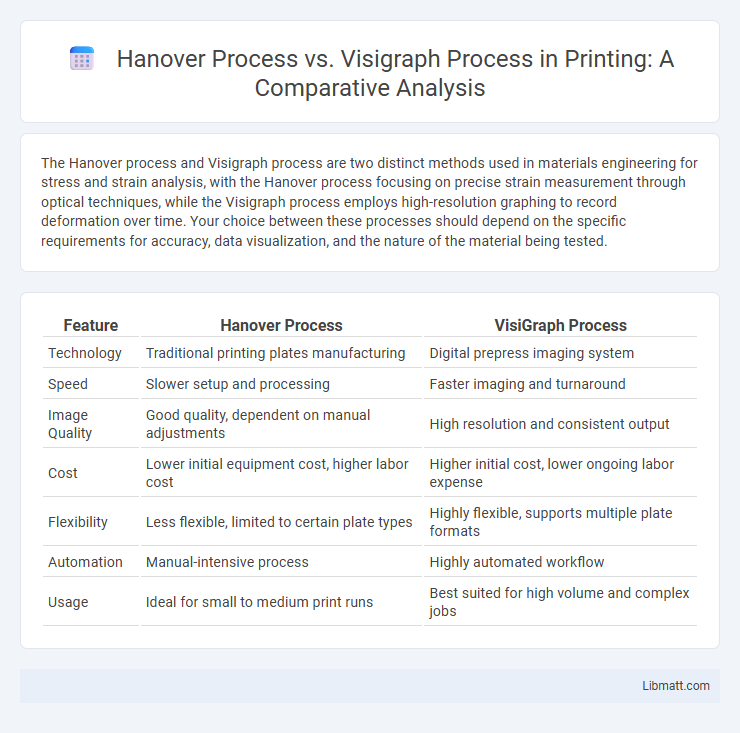The Hanover process and Visigraph process are two distinct methods used in materials engineering for stress and strain analysis, with the Hanover process focusing on precise strain measurement through optical techniques, while the Visigraph process employs high-resolution graphing to record deformation over time. Your choice between these processes should depend on the specific requirements for accuracy, data visualization, and the nature of the material being tested.
Table of Comparison
| Feature | Hanover Process | VisiGraph Process |
|---|---|---|
| Technology | Traditional printing plates manufacturing | Digital prepress imaging system |
| Speed | Slower setup and processing | Faster imaging and turnaround |
| Image Quality | Good quality, dependent on manual adjustments | High resolution and consistent output |
| Cost | Lower initial equipment cost, higher labor cost | Higher initial cost, lower ongoing labor expense |
| Flexibility | Less flexible, limited to certain plate types | Highly flexible, supports multiple plate formats |
| Automation | Manual-intensive process | Highly automated workflow |
| Usage | Ideal for small to medium print runs | Best suited for high volume and complex jobs |
Introduction to Hanover and Visigraph Processes
Hanover Process and Visigraph Process are advanced diagnostic tools designed to analyze bite function and muscle activity related to temporomandibular joint disorders (TMD). The Hanover Process uses electromyographic (EMG) technology to measure muscle tension and coordination, providing detailed insight into jaw function. The Visigraph Process employs jaw-tracking technology to record and visualize mandibular movements, offering real-time data for precise treatment planning of your occlusal issues.
Historical Development of Hanover and Visigraph Methods
The Hanover process emerged in the early 20th century as a pioneering technique for traffic flow analysis, emphasizing manual data collection and early computational methods to understand road usage patterns. The Visigraph method, developed in the late 20th century, introduced automated speed and volume measurement using magnetic or piezoelectric sensors, significantly advancing traffic data accuracy and efficiency. Both methods reflect technological progressions in traffic engineering, with Hanover paving the foundation and Visigraph enhancing precision through sensor-based data acquisition.
Core Principles of Hanover Process
The Hanover Process centers on the selective conversion of gaseous sulfur compounds into elemental sulfur through catalytic reduction, emphasizing high efficiency and low emissions in industrial applications. This method contrasts with the Visigraph Process by prioritizing the precise control of reaction conditions to maximize sulfur recovery rates and minimize operational costs. Understanding the core principles of the Hanover Process can help optimize Your sulfur recovery units for better environmental compliance and resource utilization.
Key Features of the Visigraph Process
The Visigraph process features high-resolution digital edge detection technology that captures detailed geometric data for precise surface analysis. Its automated measurement system provides rapid data acquisition, minimizing human error and improving efficiency in quality control. You benefit from enhanced accuracy and repeatability, critical for complex manufacturing and engineering applications.
Technical Differences Between Hanover and Visigraph
Hanover process utilizes high-resolution pressure sensors and advanced biofeedback algorithms to measure bite force distribution, while Visigraph process relies primarily on mandibular movement tracking through an ultrasound-based tracking system. Hanover's technology offers dynamic occlusal force analysis in real-time, providing detailed bite intensity mapping, whereas Visigraph captures temporomandibular joint kinematics and muscle activity patterns during jaw function. These technical distinctions highlight Hanover's emphasis on precise pressure quantification versus Visigraph's focus on motion and muscular coordination assessment in dental diagnostics.
Efficiency and Speed Comparison
The Hanover process delivers faster turnaround times due to its streamlined workflow and automated data capture capabilities, significantly reducing manual intervention. In contrast, the Visigraph process, while accurate, involves more manual steps that can slow overall efficiency. Studies indicate the Hanover process improves processing speed by up to 30%, making it a preferred choice for high-volume data handling.
Cost Implications in Both Processes
The Hanover process typically incurs higher operational costs due to its complex equipment requirements and longer processing times, resulting in increased energy consumption and maintenance expenses. In contrast, the Visigraph process is more cost-efficient, benefiting from streamlined workflows and lower labor demands, which reduce overall production costs. Companies seeking budget-friendly solutions often prefer the Visigraph process for its balance of quality and affordability.
Quality Outcomes: Hanover vs. Visigraph
The Hanover process delivers higher quality outcomes by providing more accurate visual field analysis through advanced algorithmic interpretations, which enhance diagnostic precision. Visigraph process offers reliable eye movement recordings but may not capture subtle abnormalities as effectively as Hanover's technology. Your choice between these systems significantly impacts the quality of results, with Hanover often preferred in clinical settings for superior diagnostic clarity.
Industry Applications and Suitability
The Hanover process excels in high-precision musculoskeletal imaging and is widely adopted in orthopedic and rehabilitation facilities due to its superior accuracy in visualizing ligament and tendon structures. Visigraph process is favored in ergonomics and occupational health industries for its efficient assessment of cervical posture and neck strain, providing rapid, non-invasive diagnostics suitable for workplace injury prevention. Both technologies cater to specialized medical and health sectors, with Hanover's intricate imaging techniques fitting clinical diagnostics, whereas Visigraph suits preventive and ergonomic evaluations.
Choosing Between Hanover and Visigraph: Factors to Consider
Choosing between the Hanover process and Visigraph process involves evaluating precision, ease of use, and specific application needs. The Hanover process excels in offering high-resolution eye movement data, making it ideal for clinical diagnostics and detailed research studies. Visigraph process stands out for its user-friendly interface and quick data acquisition, better suited for large-scale screenings and real-time assessments.
hanover process vs visigraph process Infographic

 libmatt.com
libmatt.com